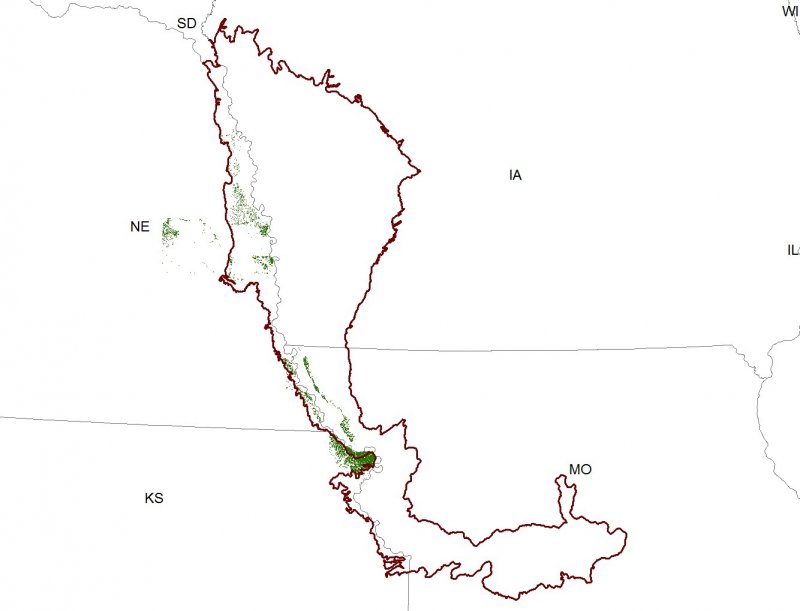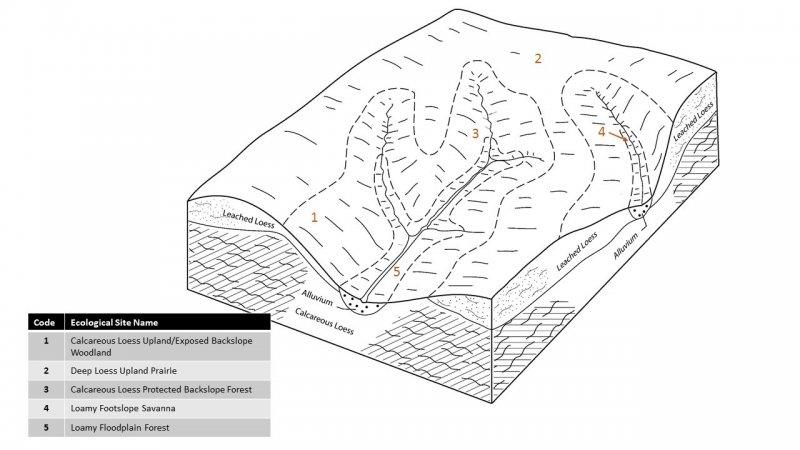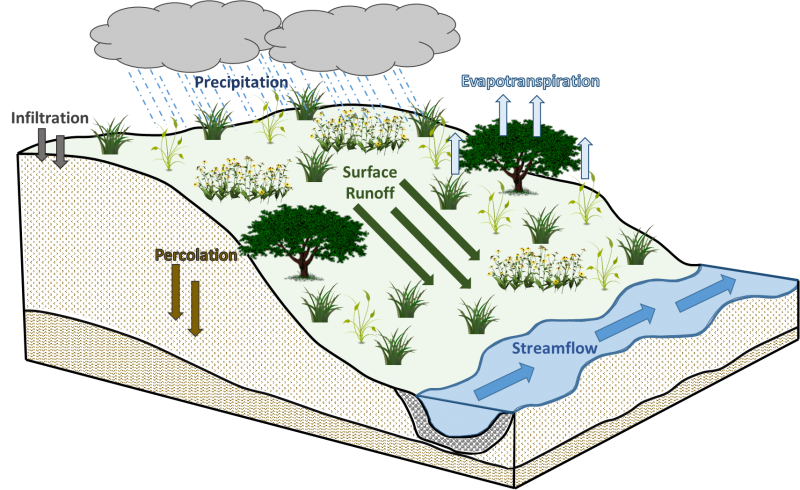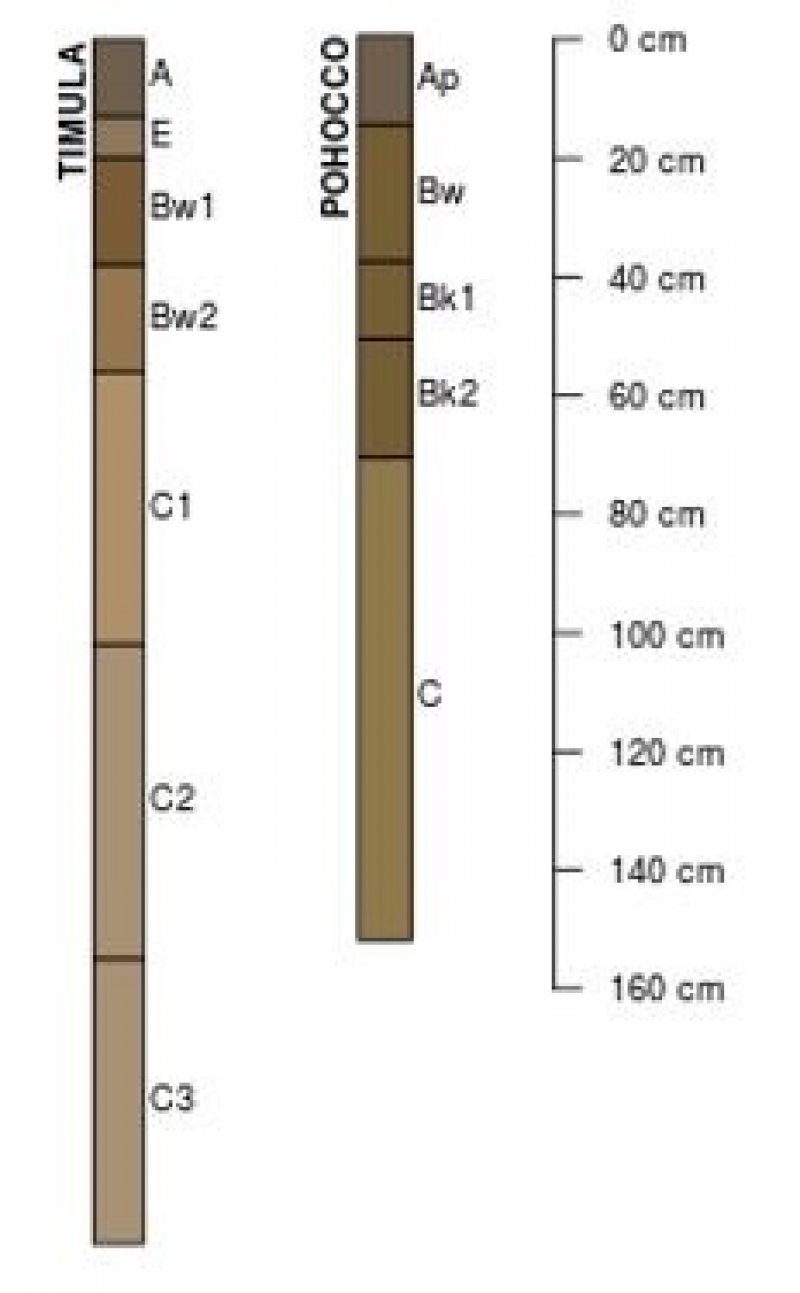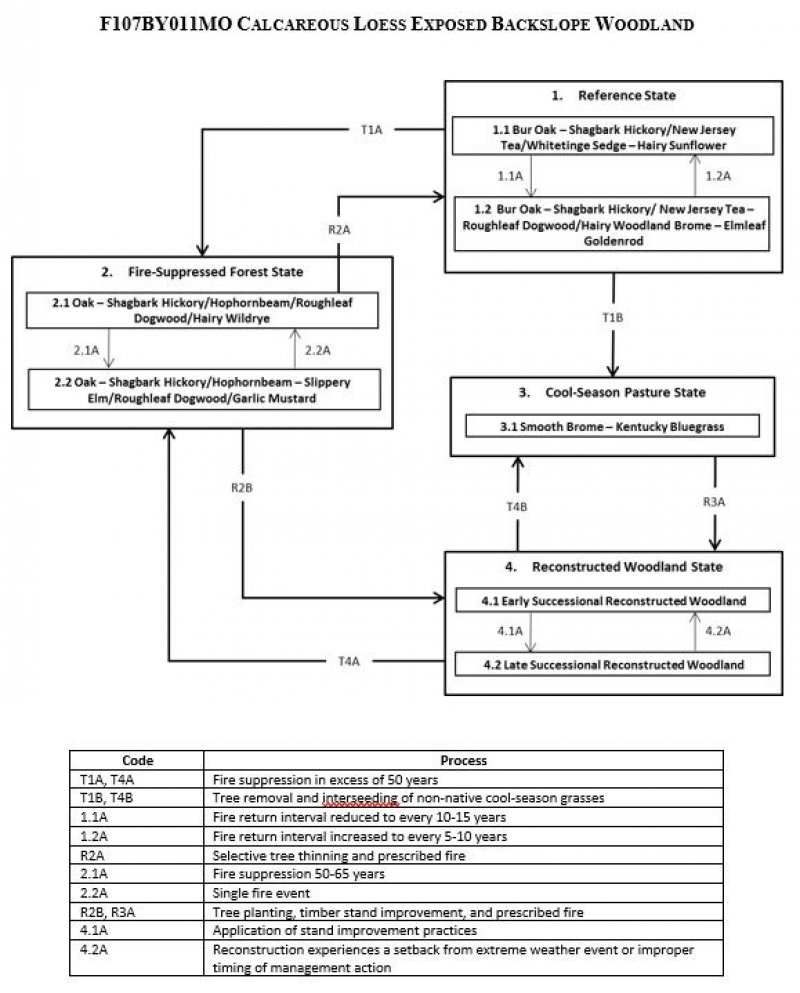
Natural Resources
Conservation Service
Ecological site F107XB011MO
Calcareous Loess Exposed Backslope Woodland
Last updated: 5/21/2020
Accessed: 12/21/2025
General information
Provisional. A provisional ecological site description has undergone quality control and quality assurance review. It contains a working state and transition model and enough information to identify the ecological site.
Figure 1. Mapped extent
Areas shown in blue indicate the maximum mapped extent of this ecological site. Other ecological sites likely occur within the highlighted areas. It is also possible for this ecological site to occur outside of highlighted areas if detailed soil survey has not been completed or recently updated.
MLRA notes
Major Land Resource Area (MLRA): 107X–Iowa and Missouri Deep Loess Hills
The Iowa and Missouri Deep Loess Hills (MLRA 107B) includes the Missouri Alluvial Plain, Loess Hills, Southern Iowa Drift Plain, and Central Dissected Till Plains landform regions (Prior 1991; Nigh and Schroeder 2002). It spans four states (Iowa, 53 percent; Missouri, 32 percent; Nebraska, 12 percent; and Kansas 3 percent), encompassing over 14,000 square miles (Figure 1). The elevation ranges from approximately 1,565 feet above sea level (ASL) on the highest ridges to about 600 feet ASL along the Missouri River near Glasgow in central Missouri. Local relief varies from 10 to 20 feet in the major river floodplains, to 50 to 100 feet in the dissected uplands, and loess bluffs of 200 to 300 feet along the Missouri River. Loess deposits cover most of the area, with deposits reaching a thickness of 65 to 200 feet in the Loess Hills and grading to about 20 feet in the eastern extent of the region. Pre-Illinoian till, deposited more than 500,000 years ago, lies beneath the loess and has experienced extensive erosion and dissection. Pennsylvanian and Cretaceous bedrock, comprised of shale, mudstones, and sandstones, lie beneath the glacial material (USDA-NRCS 2006).
The vegetation in the MLRA has undergone drastic changes over time. Spruce forests dominated the landscape 30,000 to 21,500 years ago. As the last glacial maximum peaked 21,500 to 16,000 years ago, they were replaced with open tundras and parklands. The end of the Pleistocene Epoch saw a warming climate that initially prompted the return of spruce forests, but as the warming continued, spruce trees were replaced by deciduous trees (Baker et al. 1990). Not until approximately 9,000 years ago did the vegetation transition to prairies as climatic conditions continued to warm and subsequently dry. Between 4,000 and 3,000 years ago, oak savannas began intermingling within the prairie landscape, while the more wooded and forested areas maintained a foothold in sheltered areas. This prairie-forest transition ecosystem formed the dominant landscapes until the arrival of European settlers (Baker et al. 1992).
Classification relationships
Major Land Resource Area (MLRA): Iowa and Missouri Deep Loess Hills (107B) (USDA-NRCS 2006)
USFS Subregions: Central Dissected Till Plains Section (251C), Loess Hills (251Cb) Subsection; Nebraska Rolling Hills Section (251H), Pawnee City-Seneca Rolling Hill (251Hd) (Cleland et al. 2007)
U.S. EPA Level IV Ecoregion: Steeply Rolling Loess Prairies (47e), Rolling Loess Prairies (47f), Nebraska/Kansas Loess Hills (47h) (USEPA 2013)
Biophysical Setting (LANDFIRE 2009): North-Central Interior Dry-Mesic Oak Forest and Woodland (4213100)
Ecological Systems (National Vegetation Classification System, Nature Serve 2015): North-Central Interior Dry-Mesic Oak Forest and Woodland (CES202.046)
Eilers and Roosa (1994): Upland Woods
Iowa Department of Natural Resources (INAI nd): Eastern Dry Forest
Missouri Natural Heritage Program (Nelson 2010): Dry Loess/Glacial Till Woodland
Nebraska Game and Parks Commission (Steinauer and Rolfsmeier 2003): Oak – Hickory – Ironwood Forest
Plant Associations (National Vegetation Classification System, Nature Serve 2015): Quercus alba – (Quercus velutina) – Carya ovata/Ostrya virginiana Forest (CEGL002011)
Ecological site concept
Calcareous Loess Exposed Backslope Woodlands are mapped in complex with Calcareous Loess Protected Backslope Forests and occur within the green areas on the map (Figure 1). They occur on south- and west-facing backslopes with slopes greater than fifteen percent. Soils are Inceptisols that are well-drained and very deep. These sites are developed from loess with a significant component of carbonates at or near the surface, resulting in an alkaline (increased pH) environment. These fine-silty, fertile soils have high soil uniformity resulting in increased nutrient- and water-holding capacity, increased organic matter retention, and good soil aeration that allows deep penetration by plant roots, which generally results in high plant productivity (Catt 2001). These sites occur adjacent to Calcareous Loess Upland Woodland and Calcareous Loess Protected Backslope Forest ecological sites.
The historic pre-European settlement vegetation on this site was dominated by oak-hickory woodlands. Bur oak (Quercus macrocarpa Michx.) is associated with calcareous soils and thus forms the dominant oak component (Gucker 2011). Northern red oak (Quercus rubra L.), white oak (Quercus alba L.), and black oak (Quercus velutina Lam.) are associated oak components, with the southern ranges of this ecological site also supporting chinquapin oak (Quercus muehlenbergii Engelm.) (LANDFIRE 2009; Steinauer and Rolfsmeier 2010). The hickory component occurs on a latitudinal gradient, grading from bitternut hickory (Carya cordiformis (Wangenh.) K. Koch) in the north to shagbark hickory (Carya ovata (Mill.) K. Koch) in the south. The shrub layer consists of New Jersey tea (Ceanothus americanus L.). Diagnostic species in the herbaceous layer included whitetinge sedge (Carex albicans Willd. ex Spreng.) and hairy sunflower (Helianthus hirsutus Raf.). Other herbaceous species associated with an undisturbed community could include pointedleaf ticktrefoil (Desmodium glutinosum (Muhl. ex Willd.) Alph. Wood), wild yam (Dioscorea villosa L.), button eryngo (Eryngium yuccifolium Michx.), black-seed ricegrass (Patis racemosa (Sm.) Romasch., P.M. Peterson & R.J. Soreng), and American ginseng (Panax quinquefolius L.) (Steinauer and Rolfsmeier 2010; Nelson 2010). Fire was the primary disturbance factor that maintained this site, while drought, native mammal grazing, ice damage, and periodic insect defoliation were likely secondary factors (LANDFIRE 2009).
Associated sites
| F107XB009MO |
Calcareous Loess Upland Woodland Calcareous loess soils on slopes less than 15 percent including Pohocco and Timula |
|---|---|
| F107XB011MO |
Calcareous Loess Exposed Backslope Woodland Calcareous loess soils on slopes greater than 15 percent with south and west aspects, including Pohocco and Timula |
| R107XB002MO |
Deep Loess Upland Prairie Leached soils on slopes less than 15 percent including Arents, Contrary, Deroin, Higginsville, Melia, Monona, Ponca, Sibley, Sibleyville, Strahan, Udarents, Udorthents, Wakenda |
Similar sites
| F107XB009MO |
Calcareous Loess Upland Woodland Calcareous Loess Upland Woodlands support a similar oak-hickory community, but landscape position results in a moister environment and more productive bur oak component |
|---|---|
| F107XB004MO |
Deep Loess Protected Backslope Woodland Deep Loess Protected Backslope Woodlands support a similar oak-hickory community, but the dominant oak is white oak |
Table 1. Dominant plant species
| Tree |
(1) Quercus macrocarpa |
|---|---|
| Shrub |
(1) Ceanothus americanus |
| Herbaceous |
(1) Carex albicans |
Click on box and path labels to scroll to the respective text.
